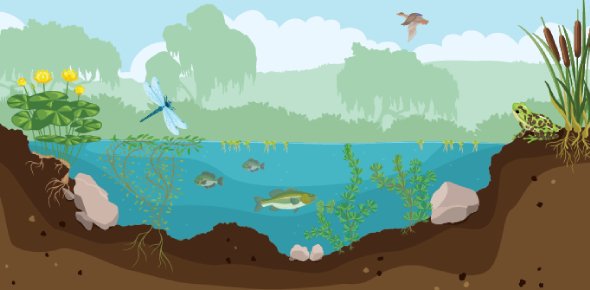Meaning Of Pond Ecosystem
Ponds are the artificial or natural bodies of water. Well, the ecosystem is the technical term for a community of organisms. Pond Ecosystem refers to a freshwater ecosystem on which different organisms depend for their survival and to fulfill their nutritional needs as well. The ponds are the water bodies that are usually 12-15 feet deep in which the sun rays can reach which results in the growth of plants down there. The components of the pond ecosystem include both biotic and abiotic components. Biotic components consist of producers, consumers, and decomposers whereas abiotic components include organic and inorganic materials. It should be noted that biotic components follow a food chain.
Types Of Pond Ecosystem
Pond Ecosystem falls in the freshwater ecosystem which is further divided into three parts which are littoral zone, open water zone, and deep water zone. The littoral zone is a zone which is an area near the shore where sunlight follows its way down and allows the plants to grow. Open water zone which actually is well known as pelagic zone. It is that zone where water is not close to the bottom nor near the shore. The last is the deepwater zone which is the lowest level lying above the sea and below the thermocline. These three types can be understood deeply. Some differentiate Pond Ecosystem in another way. It is classified into five types which are salt ponds, garden ponds, freshwater ponds, vernal ponds, and underground ponds. Salt ponds are one which is near the seaside and consist brackish water. Garden ponds are those which are artificial in nature. The freshwater pool can form anywhere because of rains. Vernal ponds are those which are created because of depression in the ground and are seasonal. Lastly, underground ponds are created near the rocks.

Characteristics Of Pond Ecosystem
Pond Ecosystems are the balance of fish, bacterias, and plants which together support each other. Pond Ecosystem works on ponds that are shallow enough for the sunlight to pass through it. It is a living ecosystem itself. Ponds do not have a universally accepted standard of their maximum size. Ponds are wet and are surrounded by artificial and natural banks. The ponds provide inhabitation to wetland plants and animals. Pond works with a combination of three food webs at a time. There exist a type of pond where no trace of fishes is to be seen. This type of pond is known as a vernal pond. These types of ponds Inhabitat are rare and endangered plant species.
Importance Of Pond Ecosystem
Pond Ecosystem has a great significance. They provide inhabitation to scarce species and support biodiversity much more than any other freshwater habitat. It is home to many species. In the midst of landscapes, the farmland ponds can provide our wildlife which is not a small thing. Every pond has a story to narrate about different people who visit them, be it for fishing or for soaking cartwheels. Ponds work as mini reservoirs which helps to drain fields during rain. Ponds recycle the nutrients and reduce the number of nitrates and phosphates. Ponds are usually man-made and are dug for different utilities of mankind. They provide drinking water during dry weather and vegetation to animals. They are not just important for quenching thirst or providing inhabitation but also to add beauty to mother nature. It touches our hearts and we feel calm and close to nature.
Conclusion on Pond Ecosystem
Ponds are found everywhere but yet they are endangered so we need to conserve them and protect them from getting extinct. We need to remember that we have to save something for future generations as well. Ponds are inhabitation to many and are very important to maintain nature.